Crop Production¶
Overview¶
The crop production module translates GAEZ yield potentials and land availability into production constraints for the optimization model. Each crop can be grown in multiple regions, on different resource classes, and potentially with either rainfed or irrigated water supply.
Crop Coverage¶
The default configuration includes over 60 crops spanning major food categories:
- Cereals
Wheat, dryland rice, wetland rice, maize
Barley, oat, rye, sorghum
Buckwheat, foxtail millet, pearl millet
- Legumes and Pulses
Soybean, dry pea, chickpea
Cowpea, gram, phaseolus bean, pigeonpea
- Roots and Tubers
White potato, sweet potato, cassava, yam
- Vegetables
Tomato, carrot, onion, cabbage
- Fruits
Banana, citrus, coconut
- Oil Crops
Sunflower, rapeseed, groundnut
Sesame, oil palm, olive
- Sugar Crops
Sugarcane, sugarbeet
- Fodder Crops
Alfalfa, biomass sorghum
The complete crop list is configured in config/default.yaml under the crops key.
Note
Managed grassland is also modelled, but yields derived from the LPJmL mode; see Grassland Yields
GAEZ Yield Data¶
Yield potentials come from the FAO/IIASA Global Agro-Ecological Zones (GAEZ) v5 dataset, which provides spatially-explicit crop suitability and attainable yields under various scenarios. The GAEZ documentation can be found here. Module II gives more details on biomass and yield calculations (including links to appendices with detailed calculations and parameter choices); subsequent modules apply climatic and technical constraints to arrive at potential yields in Module V.
All RES05 yield rasters used here are provided on a 0.083333° (~5 arc-minute, ≈9 km at the equator) latitude–longitude grid, which sets the native spatial resolution before aggregation to optimization regions.
GAEZ Configuration¶
Key GAEZ parameters in config/default.yaml:
data:
gaez:
# GAEZ v5 parameters
# Note: RES05 (yields/suitability) has ENSEMBLE, but RES02 (growing season) only has individual GCMs
climate_model: "GFDL-ESM4" # Specific GCMs: "GFDL-ESM4", "IPSL-CM6A-LR", "MPI-ESM1-2-HR", "MRI-ESM2-0", "UKESM1-0-LL"
climate_model_ensemble: "ENSEMBLE" # Multi-model mean (only available for RES05, not RES02)
period: "FP2140" # Future: "FP2140" (2021-2040), "FP4160" (2041-2060), "FP6180" (2061-2080), "FP8100" (2081-2100); Historical: "HP0120" (2001-2020), "HP8100" (1981-2000)
scenario: "SSP126" # "SSP126" (low emissions), "SSP370" (medium, ~RCP4.5), "SSP585" (high), "HIST" (historical)
input_level: "H" # "H" (High), "L" (Low)
water_supply: "R" # "I" (irrigated), "R" (rainfed)
# Variable codes for GAEZ v5
yield_var: "RES05-YCX" # Average attainable yield, current cropland
water_requirement_var: "RES05-WDC" # Water deficit/net irrigation requirement during crop cycle, current cropland
suitability_var: "RES05-SX1" # Share of grid cell assessed as VS or S (very suitable or suitable)
usda:
api_key: "NZESBYEsg9Utlh3OmIsHu7pgEI2AD3jN76SxgCq6"
retrieve_nutrition: true # Set to true to fetch nutrition data from USDA instead of using the provided data
# Nutrient mapping: internal name -> USDA FoodData Central name
# USDA names must match nutrient names in FoodData Central exactly
nutrients:
protein: "Protein"
carb: "Carbohydrate, by difference"
fat: "Total lipid (fat)"
kcal: "Energy"
land_cover:
year: "2022"
version: "v2_1_1"
soilgrids:
target_resolution_m: 10000 # Target resolution in meters (10000m = 10km)
Climate Models: Individual global circulation models (GCMs): GFDL-ESM4, IPSL-CM6A-LR, MPI-ESM1-2-HR, MRI-ESM2-0, UKESM1-0-LL; or multi-model ENSEMBLE
- Periods:
Historical: HP8100 (1981-2000), HP0120 (2001-2020)
Future: FP2140 (2021-2040), FP4160 (2041-2060), FP6180 (2061-2080), FP8100 (2081-2100)
Scenarios: SSP126 (low emissions), SSP370 (medium), SSP585 (high), HIST (historical)
- Input Levels:
“H” (high): Modern agricultural inputs (fertilizer, irrigation, pest management)
“L” (low): Subsistence farming practices
GAEZ Variables¶
The model uses several GAEZ raster products for each crop:
YCX (RES05): Attainable yield on current cropland (kg/ha or other units)
SX1 (RES05): Suitability index (fraction of gridcell suitable for cultivation)
WDC (RES05): Net irrigation water requirement during crop cycle (mm)
Growing season start (RES02): Julian day when growing season begins
Growing season length (RES02): Number of days in growing cycle
Note
RES05 (yields/suitability) supports ENSEMBLE, but RES02 (growing season) only has individual GCM outputs.
The following figures show yield potential maps for three major crops, illustrating the spatial variation in productivity that drives the optimization:
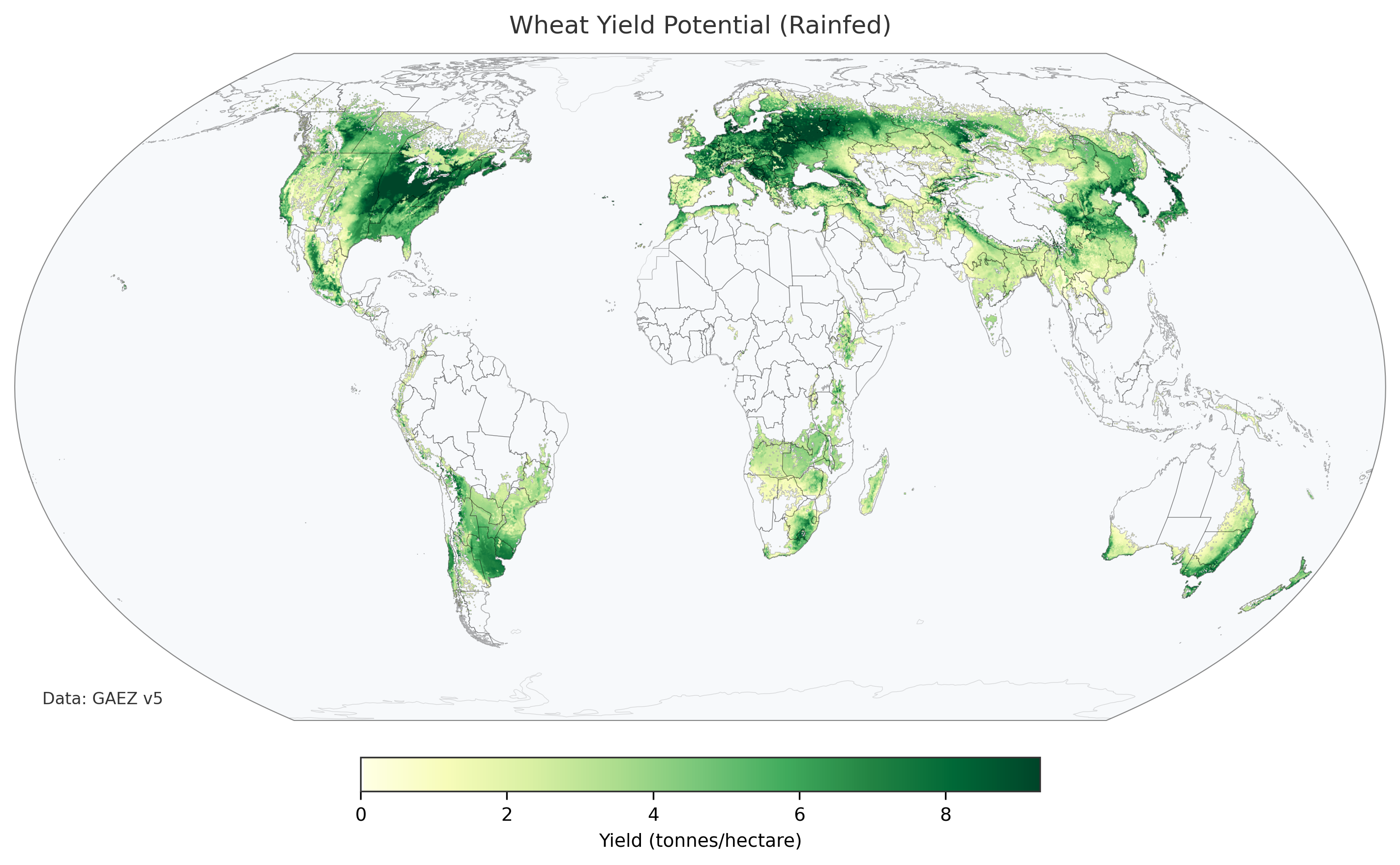
Wheat rainfed yield potential (tonnes/hectare) from GAEZ v5. Higher yields are shown in darker green. Black lines indicate region boundaries. Wheat performs best in temperate zones with adequate rainfall.¶
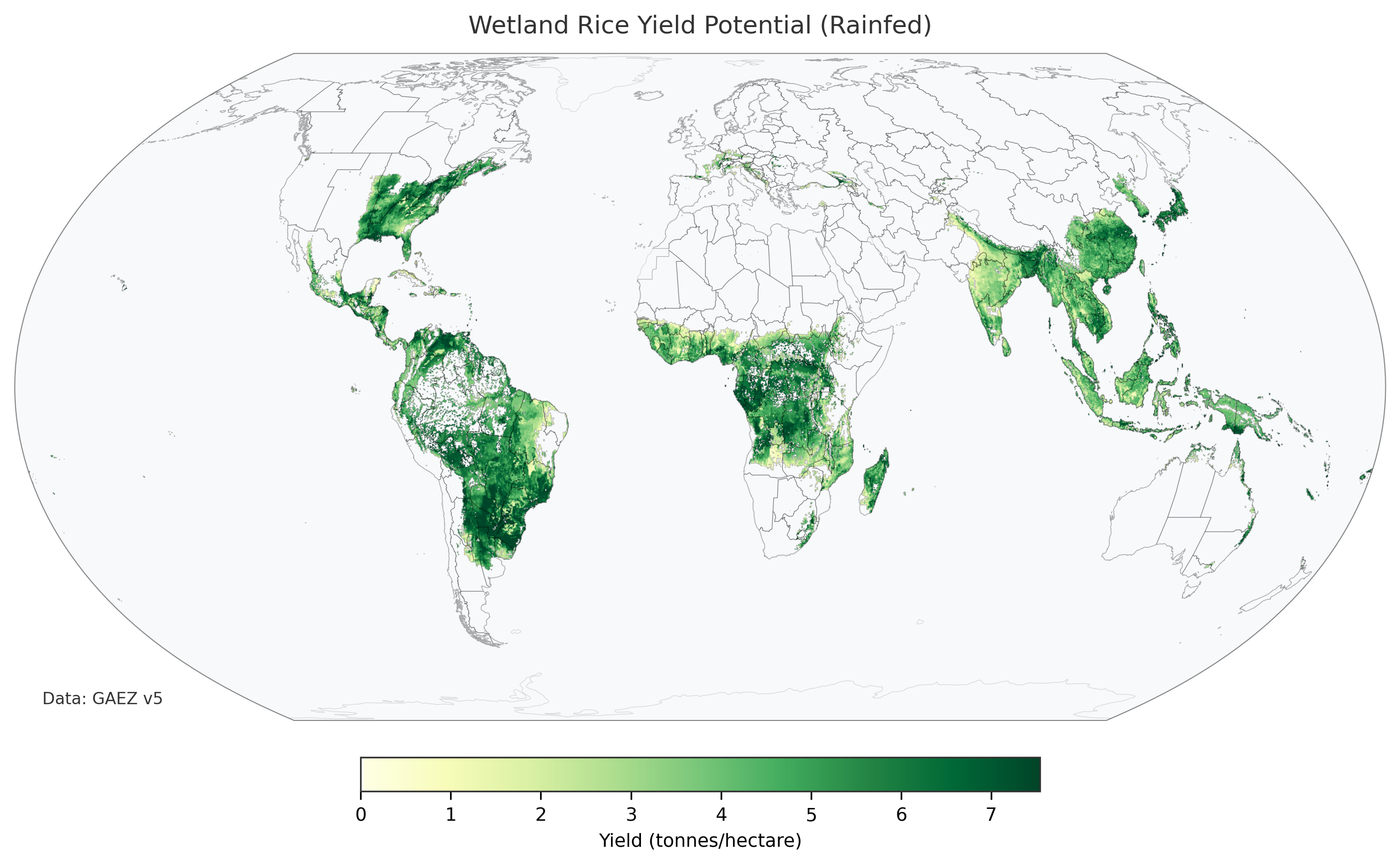
Wetland rice rainfed yield potential (tonnes/hectare) from GAEZ v5. Rice shows high productivity in tropical and subtropical regions with suitable water availability, particularly in Asia.¶
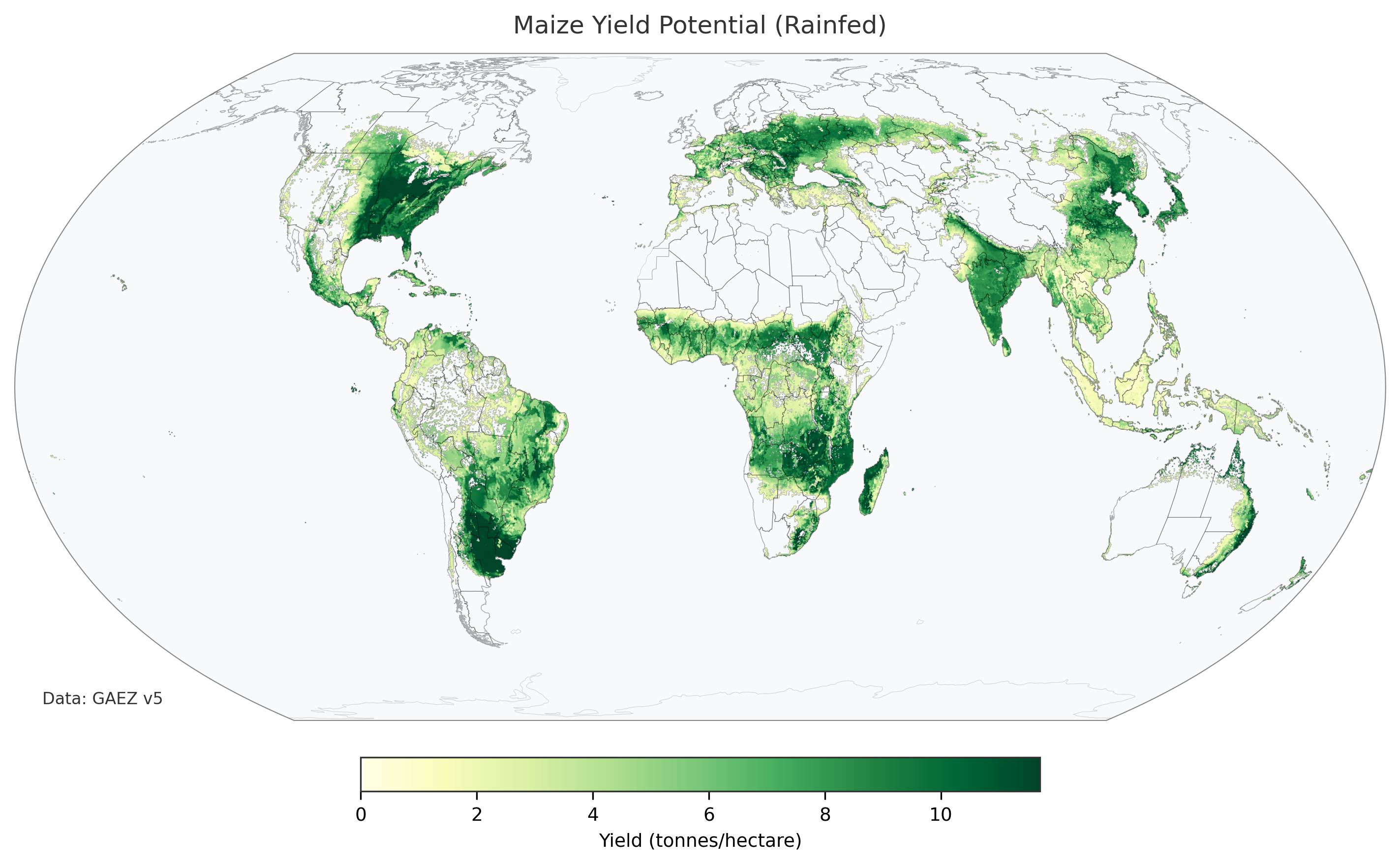
Maize rainfed yield potential (tonnes/hectare) from GAEZ v5. Maize is adaptable across diverse climates, with strong yields in the Americas, parts of Africa, and temperate zones.¶
Yield Aggregation¶
Yields are aggregated from the input resolution gridcells to (region, resource_class, water_supply) combinations by workflow/scripts/build_crop_yields.py.
Aggregation Process¶
Load resource classes: Read the class assignment raster (see Land Use & Resource Classes)
Load crop-specific rasters:
Yield potential (kg/ha, converted to t/ha)
Suitability fraction (0-1)
Water requirement (mm, converted to m³/ha)
Growing season timing (start day, length)
Unit conversions: Apply crop-specific conversion factors
Default: 0.001 (kg/ha → t/ha)
Custom factors in
data/yield_unit_conversions.csv(e.g., sugarcane in GE/ha)
Mask by suitability: Only aggregate over suitable land (SX1 > 0)
Compute class averages: Within each (region, resource_class) combination:
Mean yield (t/ha) weighted by suitable area
Mean water requirement (m³/ha)
Modal growing season start and length
Output: CSV file (
processing/{name}/crop_yields/{crop}_{water_supply}.csv) with tidy columns:region– Optimization region IDresource_class– Class numbervariable– One ofyield,suitable_area,water_requirement_m3_per_ha,growing_season_start_day,growing_season_length_daysunit– Physical unit for the variable (t/ha,ha,m³/ha,day-of-year,days)value– Numeric value for the (region, class, variable) triplet
Resource Class Yields¶
Because resource classes are defined by yield quantiles (see Land Use & Resource Classes), yields generally increase with class number. For example, in a particular region with quantiles [0.25, 0.5, 0.75], we might see the following average yields by resource class:
Class 0: 1.5 t/ha (bottom quartile land)
Class 1: 2.8 t/ha (second quartile)
Class 2: 4.2 t/ha (third quartile)
Class 3: 6.5 t/ha (top quartile)
This allows the optimizer to preferentially allocate crops to high-quality land or expand onto marginal land as needed.
The following figure illustrates this variation, comparing rainfed wheat yields between resource classes 1 and 2 across all regions:
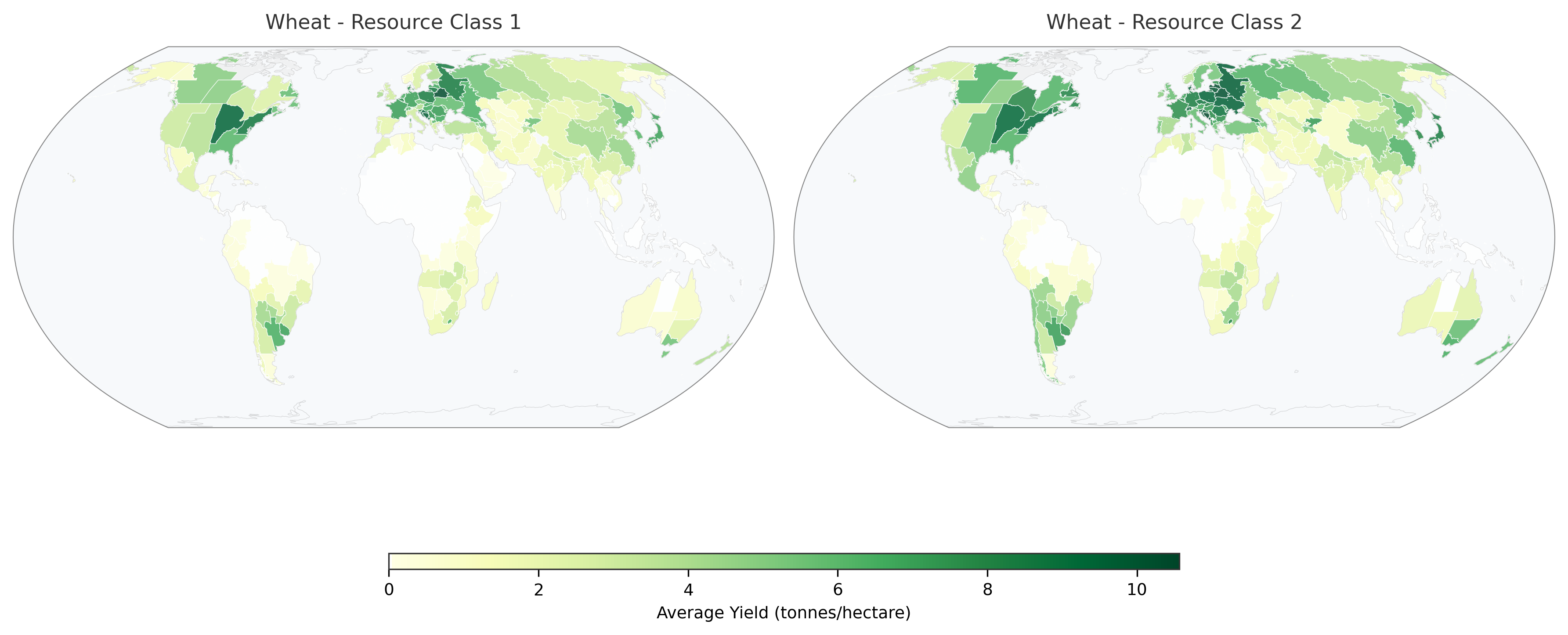
Comparison of wheat rainfed yields (tonnes/hectare) between resource class 1 (left) and resource class 2 (right). Resource class 2 represents higher-quality land and generally shows higher yields across most regions, demonstrating how the resource class stratification captures land quality variation.¶
Note
Yields for individual crops need not always be better in a high resource class. This is because resource classes are determined “globally” for all crops at once, so that each grid cell is assigned a resource class independent of any crop. So while resource class 2 has better average yields than resource class 1 in every region, that might not be true for some individual crops (e.g. rainfed wheat in the Western USA region in the above example.)
Production Constraints¶
In the PyPSA model (workflow/scripts/build_model.py), crop production is represented as multi-bus links:
- Inputs:
Land (from land bus for the region/class/water combination)
Water (for irrigated crops only)
Fertilizer (for all crops, with configurable N-P-K requirements)
- Outputs:
Crop product (to crop bus)
Emissions (CO₂, CH₄, N₂O)
- Efficiency Parameters:
efficiency(bus0→bus1): Yield in t/haefficiency2(bus2, negative): Water requirement in m³/tefficiency3(bus3, negative): Fertilizer requirement in kg/tefficiency4(bus4, positive): Emissions in tCO₂-eq/t
When crops are converted into foods, the model first rescales the dry-matter crop bus to fresh edible mass using FAO edible portion coefficients and moisture shares derived from processing/{name}/fao_edible_portion.csv. The scaling factor edible_portion_coefficient / (1 - water_fraction) is applied before product-specific extraction factors in data/foods.csv. Crops listed in data/yield_unit_conversions.csv are assumed to already represent processed outputs and therefore skip this rescaling step.
Crop-specific exceptions: For certain crops, FAO’s edible portion coefficients do not match the model’s yield units, requiring special handling in workflow/scripts/prepare_fao_edible_portion.py:
Grains (rice, barley, oat, buckwheat): FAO coefficients reflect milled/hulled conversion, but we track whole grain. Coefficient forced to 1.0; milling handled separately.
Oil crops (rapeseed, olive): GAEZ yields are already in kg oil/ha (see
data/yield_unit_conversions.csv), so no further conversion needed. Coefficient forced to 1.0.Sugar crops (sugarcane, sugarbeet): GAEZ yields are already in kg sugar/ha (see
data/yield_unit_conversions.csv), so no further conversion needed. Coefficient forced to 1.0.
The model constrains:
Total land used per (region, class, water) ≤ available land
Total water used per region ≤ blue water availability (see water constraints)
Total fertilizer used globally ≤ global fertilizer limit
Water Constraints¶
For irrigated crops, water availability is a key constraint. The model tracks blue water availability by basin and growing season.
Basin-Level Availability¶
The model uses the Water Footprint Network’s monthly blue water availability dataset for 405 GRDC river basins [hoekstra2011].
Processing steps (workflow/scripts/process_blue_water_availability.py):
Load basin shapefile with monthly availability (Mm³/month)
Aggregate by basin and month to get monthly water budgets
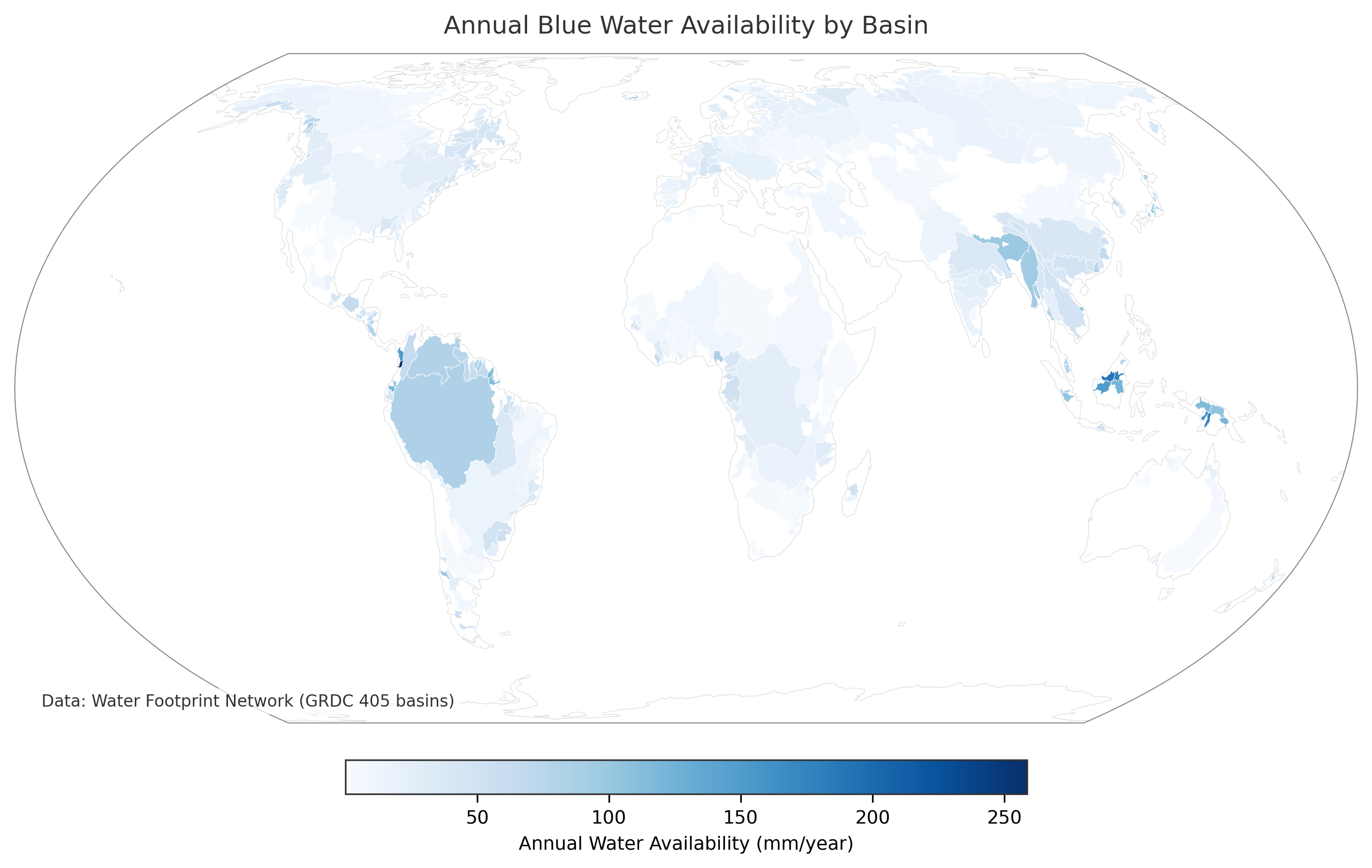
Annual blue water availability by GRDC river basin (mm/year). The map shows area-normalized yearly water availability across 405 major river basins globally. Higher availability is shown in darker blue, allowing direct comparison between basins of different sizes. While we normalize by area for better visualisation here, food-opt tracks total water amount availability internally.¶
Regional Water Assignment¶
Blue water availability is allocated to optimization regions based on spatial overlap with basins (workflow/scripts/build_region_water_availability.py):
Spatial join: Intersect region polygons with basin polygons
Area weighting: Allocate basin water proportional to overlap area
Growing season matching: Assign water to regions based on when crops are growing
Uses growing season start/length from GAEZ
Sums monthly availability over the growing period
For now, this is done on average over all crops that can grow in the region
Output: CSV files:
processing/{name}/water/monthly_region_water.csv: Monthly water by regionprocessing/{name}/water/region_growing_season_water.csv: Growing season totals
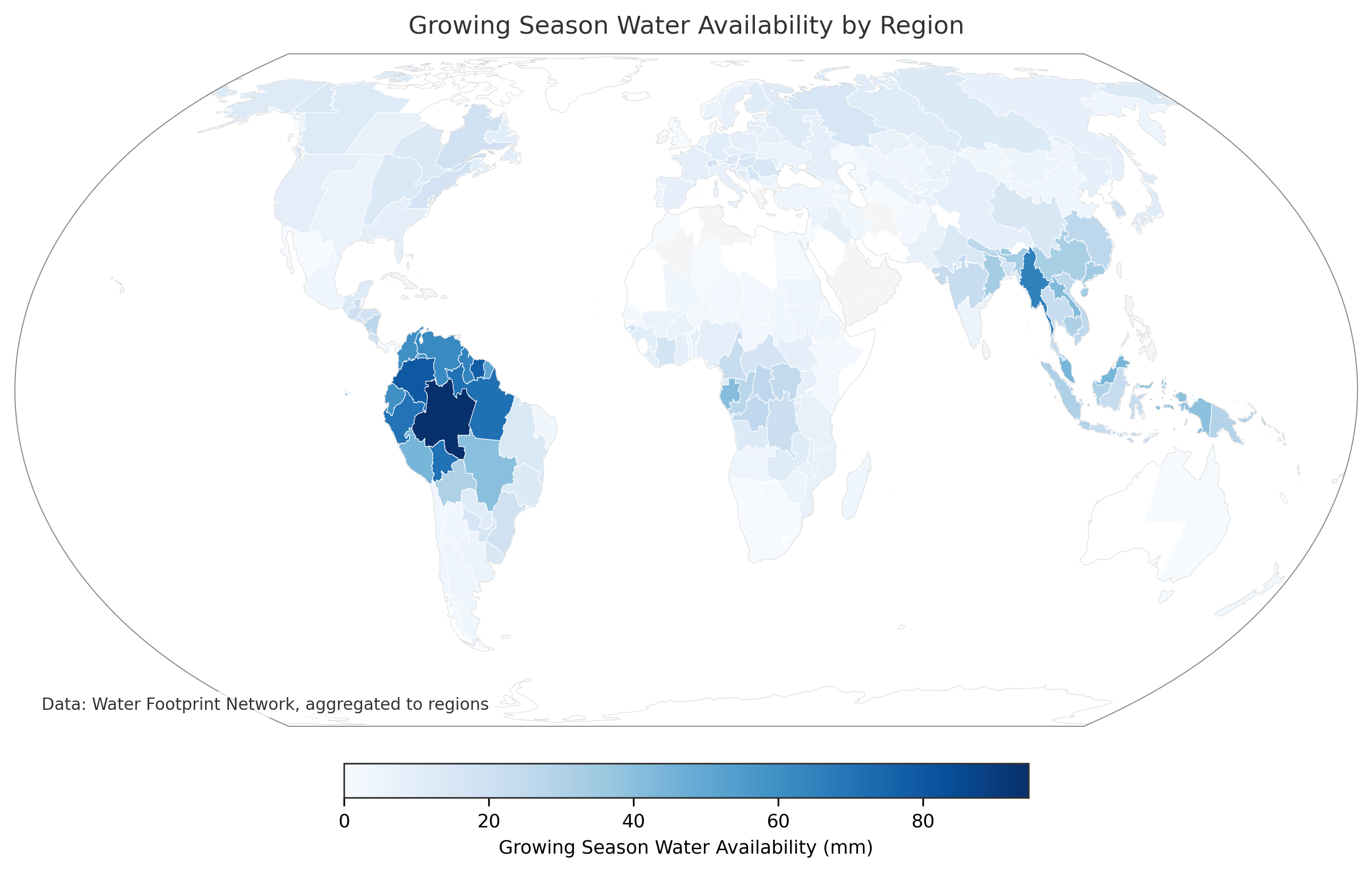
Growing season water availability by optimization region (mm). The map shows area-normalized water available during the average growing season for each region, computed by summing monthly basin availability over the typical crop growing period. This represents the blue water constraint for irrigated crop production in the optimization model.¶
Irrigated Land Availability¶
Only a fraction of agricultural land is equipped with irrigation infrastructure. The model uses GAEZ v5’s “land equipped for irrigation” dataset (LR-IRR) to determine which land can support irrigated crops.
Key features:
Spatial variation: Irrigated land fraction varies by location based on infrastructure, water access, and historical development
Land competition: Rainfed and irrigated production compete for the same physical land
Water coupling: Irrigated land must have both irrigation infrastructure and sufficient blue water availability
The following figure shows the global distribution of land equipped for irrigation:
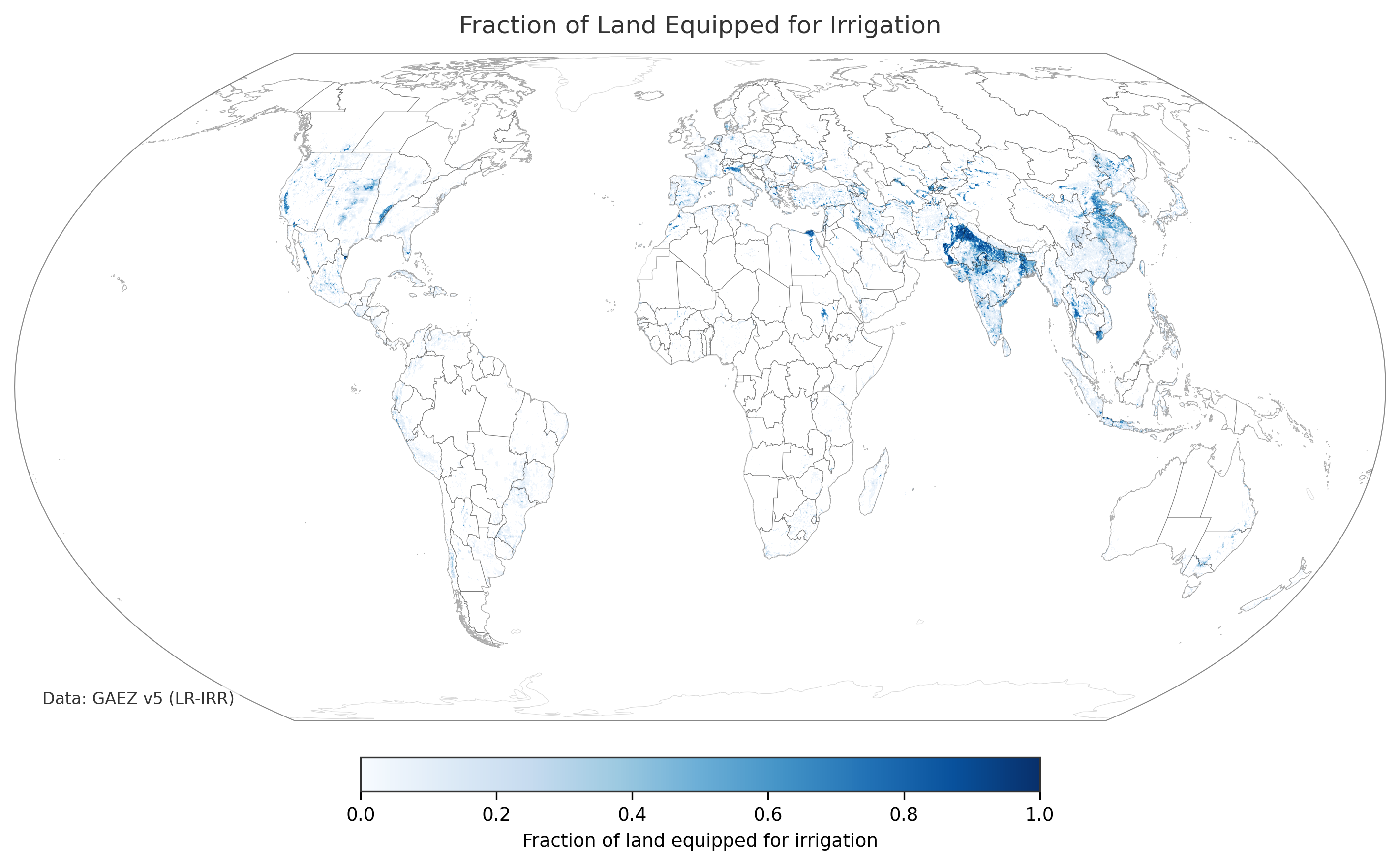
Fraction of land equipped for irrigation from GAEZ v5. Higher values (darker colors) indicate areas with more extensive irrigation infrastructure. Many agricultural regions show low irrigation fractions, limiting irrigated crop production even when water is available.¶
Interaction with rainfed cropland:
Within each optimization region and resource class, the model maintains separate variables for rainfed and irrigated land use. However, these share the same physical land base:
Rainfed land limit: Total suitable cropland minus irrigated share
Irrigated land limit: Total suitable cropland times irrigated share
Constraint: Rainfed area + irrigated area ≤ total suitable cropland
This means that in regions with limited irrigation infrastructure, the model may:
Prioritize irrigated production on the best land (higher resource classes) when water is available
Fall back to rainfed production when irrigation infrastructure or water is limiting
Trade off between high-yield irrigated crops (requiring both infrastructure and water) and lower-yield rainfed crops (requiring neither)
The irrigation infrastructure constraint is particularly important in regions where water is abundant but irrigation systems are not widely deployed, preventing the model from unrealistically converting all suitable land to high-yield irrigated production.
Fertilizer¶
Crop production requires nitrogen (N), phosphorus (P), and potassium (K) fertilizers. The model includes:
Global fertilizer limit: Total NPK available (
primary.fertilizer.limitin config, specified in kg and converted to Mt internally)Crop-specific requirements: Fertilizer needed per tonne of production (from
data/crops.csv)Emissions factors: N₂O emissions from nitrogen application
The fertilizer constraint is typically set at a realistic global scale (e.g., 200 Mt NPK/year) to prevent unrealistic intensification.
For now, N, P & K are not differentiated, and their GHG emissions are not tracked appropriately; this is work in development.
Growing Seasons¶
Temporal overlap of growing seasons within a region affects:
Water availability: Multiple crops may compete for water during the same months
Land use: Double-cropping potential if growing seasons don’t overlap
Currently, the model uses annual time resolution, so it implicitly assumes:
Each land parcel produces one crop per year
Water constraints apply to the full growing season
Allowing for growing multiple crops a year is work in development.
Crop-Specific Data Files¶
- data/crops.csv
Long-form crop parameter table (mock starter data). Each row represents a
(crop, param)pair:crop: Crop identifier matching entries used in configs and raster filenamesparam: Parameter key (currentlyfertilizer,co2, orch4)unit: Unit string forvalue(e.g.,kg/t)value: Numeric parameter value interpreted according toparamdescription: Free-text explanation of the assumption
Add new parameters by appending rows; comment lines starting with
#are ignored by loaders.- data/gaez_crop_code_mapping.csv
Lookup table aligning food-opt crop identifiers with GAEZ resource codes. Columns:
crop_name,description, and the RES02/RES05/RES06 codes used to locate raster layers.- data/yield_unit_conversions.csv
Optional per-crop overrides for converting raw GAEZ yields to tonnes per hectare. Columns:
code(GAEZ crop code used in filenames),factor_to_t_per_ha(multiplier applied to raster values), andnotefor context. Unlisted crops fall back to the default0.001factor.
Workflow Rules¶
Crop yield processing is handled by the build_crop_yields rule:
Input: Resource classes, GAEZ rasters (yield, suitability, water, growing season), regions, unit conversions
Wildcards:
{crop}(crop name),{water_supply}(“r” or “i”)Output:
processing/{name}/crop_yields/{crop}_{water_supply}.csvScript:
workflow/scripts/build_crop_yields.py
Run for a specific crop with:
tools/smk -j1 processing/{name}/crop_yields/wheat_r.csv
Or for all crops automatically via dependencies of the build_model rule.
References¶
Hoekstra, A.Y. and Mekonnen, M.M. (2011) Global water scarcity: monthly blue water footprint compared to blue water availability for the world’s major river basins, Value of Water Research Report Series No. 53, UNESCO-IHE, Delft, the Netherlands. http://www.waterfootprint.org/Reports/Report53-GlobalBlueWaterScarcity.pdf